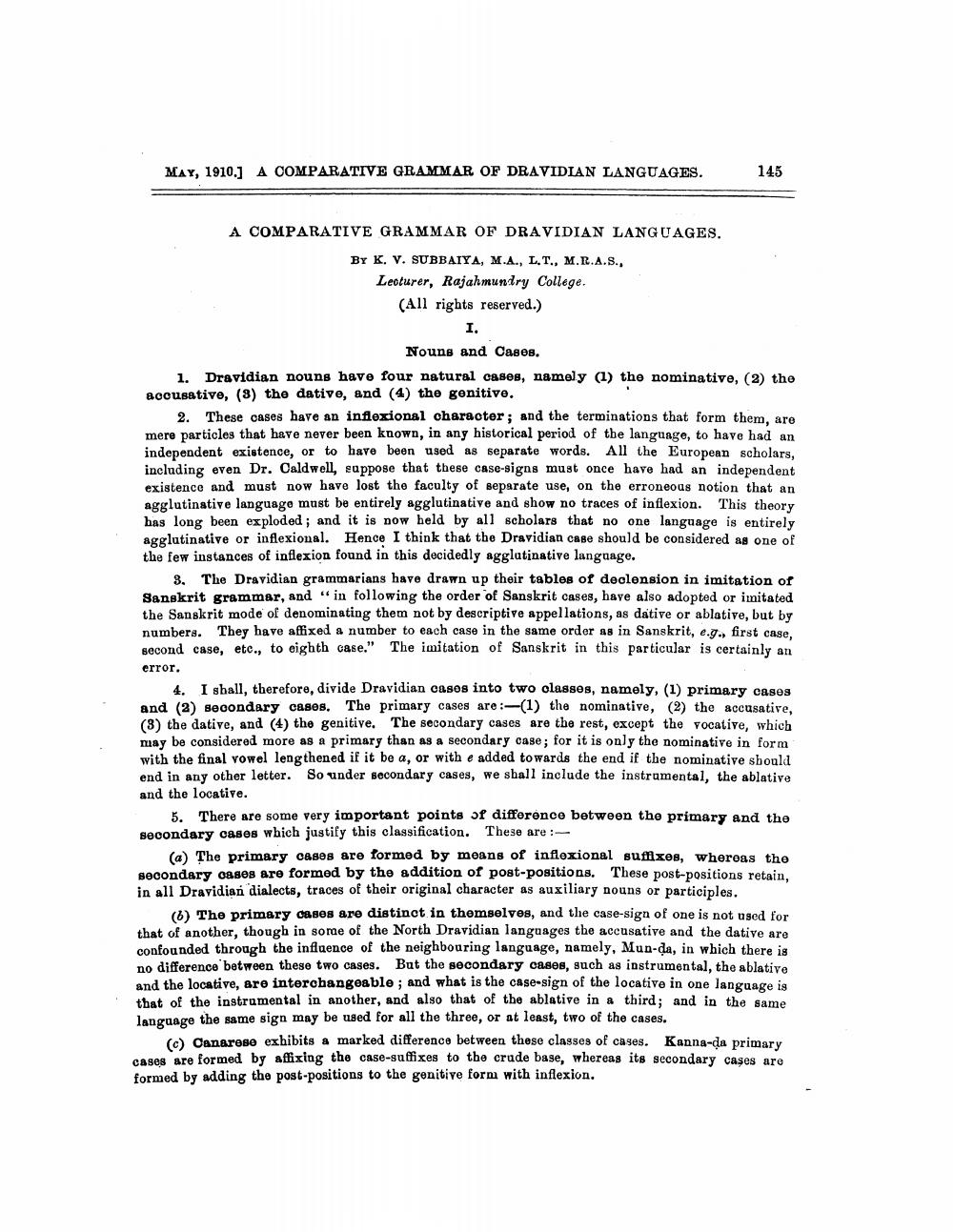________________
MAY, 1910.] A COMPARATIVE GRAMMAR OF DRAVIDIAN LANGUAGES.
A COMPARATIVE GRAMMAR OF DRAVIDIAN LANGUAGES. BY K. V. SUBBAIYA, M.A., L.T., M.R.A.S., Lecturer, Rajahmundry College. (All rights reserved.)
I.
Nouns and Cases.
145
1. Dravidian nouns have four natural cases, namely (1) the nominative, (2) the accusative, (3) the dative, and (4) the genitive.
2. These cases have an inflexional character; and the terminations that form them, are mere particles that have never been known, in any historical period of the language, to have had an independent existence, or to have been used as separate words. All the European scholars, including even Dr. Caldwell, suppose that these case-signs must once have had an independent existence and must now have lost the faculty of separate use, on the erroneous notion that an agglutinative language must be entirely agglutinative and show no traces of inflexion. This theory has long been exploded; and it is now held by all scholars that no one language is entirely agglutinative or inflexional. Hence I think that the Dravidian case should be considered as one of the few instances of inflexion found in this decidedly agglutinative language.
3. The Dravidian grammarians have drawn up their tables of declension in imitation of Sanskrit grammar, and "in following the order of Sanskrit cases, have also adopted or imitated the Sanskrit mode of denominating them not by descriptive appellations, as dative or ablative, but by numbers. They have affixed a number to each case in the same order as in Sanskrit, e.g., first case, second case, etc., to eighth case." The imitation of Sanskrit in this particular is certainly an
error.
4. I shall, therefore, divide Dravidian cases into two classes, namely, (1) primary cases and (2) secondary cases. The primary cases are:-(1) the nominative, (2) the accusative, (3) the dative, and (4) the genitive. The secondary cases are the rest, except the vocative, which may be considered more as a primary than as a secondary case; for it is only the nominative in form with the final vowel lengthened if it be a, or with e added towards the end if the nominative should end in any other letter. So under secondary cases, we shall include the instrumental, the ablative and the locative.
5. There are some very important points of difference between the primary and the secondary cases which justify this classification. These are:
(a) The primary cases are formed by means of inflexional suffixes, whereas the secondary cases are formed by the addition of post-positions. These post-positions retain, in all Dravidian dialects, traces of their original character as auxiliary nouns or participles.
(b) The primary cases are distinct in themselves, and the case-sign of one is not used for that of another, though in some of the North Dravidian languages the accusative and the dative are confounded through the influence of the neighbouring language, namely, Mun-da, in which there is no difference between these two cases. But the secondary cases, such as instrumental, the ablative and the locative, are interchangeable; and what is the case-sign of the locative in one language is that of the instrumental in another, and also that of the ablative in a third; and in the same language the same sign may be used for all the three, or at least, two of the cases.
(c) Canarese exhibits a marked difference between these classes of cases. Kanna-ḍa primary cases are formed by affixing the case-suffixes to the crude base, whereas its secondary cases are formed by adding the post-positions to the genitive form with inflexion.




